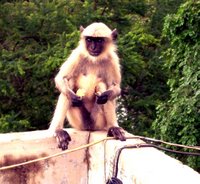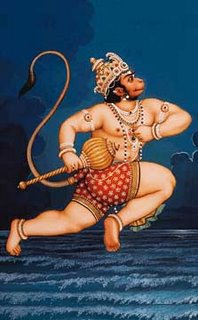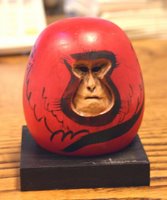[ . BACK to Worldkigo TOP . ]
:::::::::::::::::::::::::::::::::::::::::::::::::::::::::::::::::::::::::::::::::::::::::::::::::::::
Monkey
***** Location: India, other areas
***** Season: Non-seasonal Topic
***** Category: Animal
*****************************
Explanation
There are many species of monkeys.
Langur Monkey
The langur monkey is called ''leaf monkeys'' because they eat chiefly leaves. The large stomach and intestines of these monkeys give them potbellied appearance. They also eat fruit, flowers, grass.
The langur monkey has a slender body, with a long tail. Their coat may be red, brown, silver, gray, golden, or black so he can blend in with the places they live in. The adult langur weigh from 11 to 40 pounds. They measure 17 to 31 inches tall, their tail is 21 to 42 inches long. Male langurs are larger then females.
They live in warm humid swamp forest to cold mountains. They live in groups from 10 to 40 members. The langur can jump over a river. They can jump 10 meters
Langur Information Makalapa
xxxxxxxxxxxxxxxxxxxxxxxxxxxxx
Monkeys at the University Roof

© Photos by Johannes Manjrekar
xxxxxxxxxxxxxxxxxxxxxxxxxxxxx
The famous Hanuman, the Monkey King !
Hanuman is the son of Vayu, the Hindu god of Wind, and is looked upon by Hindus as the ultimate hero. He represents the figure of the ideal being, as he is humble yet brave. His physical prowess, mental discipline and spiritual purity have made him extremely popular all over India.

As a child, Hanuman mistook the rising sun for a fruit and tried to eat it, in the process disrupting the movements of the nine astrological bodies, the Grahas. When Indra, lord of the skies, hurled his thunderbolt to stop Hanuman, Vayu was so angry that he sucked away the air from the three worlds causing all creatures to choke. Vayu wouldn't release the wind until Indra promised to give Hanuman supernatural powers.
Hanuman is best known from the Indian epic the
Ramayana. In this masterwork, Sita, the wife of Prince Rama, is abducted by the demon Ravana. Hanuman leads his army of monkeys and bears to build a bridge from India to the island of Lanka, where Sita was being held.
As Hanuman's armies attacked, Prince Rama rode in on Hanuman's shoulders and fired an arrow into Ravana, killing the demon and liberating Sita.
http://www.siamese-dream.com/reference/hanuman.html
The Mystery of Hanuman
Inspiring Tales from Art and Mythology
In Hindu symbolism, a monkey signifies the human mind, which is ever restless and never still.
The Spiritual Significance of Hanuman
The goal of all mystical yearning is union of the individual soul with the universal soul. In the Adhyatma ('spiritual') Ramayana, a Sanskrit text dating from the fourteenth or fifteenth century, Sita represents the individual (jiva-atma), which has separated from the universal (param-atma) symbolized by Rama. In a beautiful interpretation, Hanuman here is said to personify bhakti, which annihilates the 'ahankara' or ego (Ravana), and re-unites the two.
Read the full article by Nitin Kumar
Exotic India
:::::::::::::::::::::::::::::::::::::::::::::::::::::::::::::::::::::::::::::::::::::::::::::::::::::
In Hindu symbolism, a monkey signifies the human mind, which is ever restless and never still.
Adyaathma Raamaayana is a demystified version of a divine text venerated by innumerable people. Raamaayana is an Ithihaasa [ancient history] so old it is undatable: even the Sanskrit style involves a different grammar I hope people dont demystify The Gods into crude abstractions of Advaita or others.
Hanuman is the eleventh manifestation of Rudra Shiva and still Exists as a Chiranjeevi [ Ever Living ] available for perception in his glorious form.
Hanuman is one of my primary Guru(s)! He initiated me in a dream into yoga about thirty years ago when He appeared in a divine luminous space and showed me my death and my own subtle body[ sooshma shariram ]which passes on into other worlds after death . He also appeared to me in another dream about eight years ago when he revealed his Vishwaroopaam [Cosmic Form].
Anjaneya Hanuman is divinely ornamented with cosmic jewels and he is luminous golden in colour in my visions. Hanuman is also mentioned in other Puraanaas . It may be noted that Anjaneya is also hailed as the greatest linguist grammarian and musician apart from being the special Guru for martial arts like Kalari payatttu [ from Kerala] Gusthi [Wrestling] etc.
Hanuman's Sahasranaama [ thousand names ] are also recited and Lord Sri Rama is The Rishi (Seer) of this revelatory mantram.
Of course, Hanuman is the greatest Bhaktha [devotee] .
Narayanan Raghunathan, August 2006
*****************************
Worldwide use
Japan
monkey, saru 猿
. . . . .
kigo for alll winter
kanen, kan en 寒猿 (かんえん) monkey in the cold
saur sakaru 猿さかる(さるさかる) monkey in heat
. 温泉猿 Monkeys sitting in the Hot Springs !
. . . . .
kigo for the New Year
saru mawashi 猿廻し (さるまわし) monkey dance performance
saru hiki 猿曳(さるひき)
saru hiki 猿引(さるひき)
saru mai shi 猿舞師(さるまいし))trainer of dancing monkeys
maizaru 舞猿(まいざる)dancing monkey
tayuuzaru 大夫猿(たゆうざる)"acting monkey"
. Dance and Kigo .
.................................................................................
Saiyuki, also known as
Genso maden Saiyuki (幻想魔伝最遊記, Gensōmaden Saiyūki?, lit. Romanticized Tale of a Journey to the Extreme)
saiyuuki "西遊記" ("Journey to the West" )
Xī Yóu Jì (西遊記) in Chinese
deals with the fortunes of four fighters - the monk Genjyo Sanzo (Romanized Genjo in the anime and Singapore English manga), the monkey deity Son Goku, the half-demon Sha Gojyo (sometimes spelled Gojou), and the demon Cho Hakkai, who have been dispatched by the Sanbutsushin (The Three Aspects of the Buddha) to India to investigate the reasons behind the recent insanity among the demons. Demons, who have formerly coexisted peacefully with humans in Shangri-La, are going berserk and turning against them.
Genjo Sanzo (Genjoo Sanzoo 玄奘三蔵) — Xuan Zang (玄奘) or Tang San Zan (Tang's three scriptures), Buddhist monk who uses a gun which can exterminate demons and a fan to silence Goku and Gojyo when they start to quarrel and can use sutras to defeat stronger demons.
Son Gokū — Sūn Wùkōng (孫悟空),
the monkey king, who is equipped with:
kinkoji (緊箍児), a magical head band placed by Sanzō Hōshi / Xuan Zang
nyoiboo (如意棒), an extendable fighting stick
kinto-un (觔斗雲), cloud mobile
Read more in the WIKIPEDIA
SARU, meaning "to go away, to pass" also a sentence like MA GA SARU 魔が去る, the evil will go away, made the monkey (saru) a special object of bringing good luck in Japan.
. Monkey Amulets and Talismans .
ooo ooo ooo ooo ooo ooo ooo ooo ooo
See no evil, hear no evil, speak no evil!
 Jizo statue of a monkey in Sugamo, Tokyo. The pedestal carving depicts the Three Monkeys covering eyes, ears and mouth.
© PHOTO nipponia / animals
Jizo statue of a monkey in Sugamo, Tokyo. The pedestal carving depicts the Three Monkeys covering eyes, ears and mouth.
© PHOTO nipponia / animals
monkey teachers . . .
to observe, to listen
to recite haiku
Gabi Greve
another look at the three wise monkeys

:::::::::::::::::::::::::::::::::::::::::::::::::::::::::::::::::::::::::::::::::::::::::::::::::::::
Monkey's Raincoat
初しぐれ猿も小蓑をほしげ也
hatsushigure saru mo komino o hoshige nari
first snow shower -
even the monkeys would want
a straw raincoat
(Tr. Gabi Greve)
Sarumino 猿蓑 : Linked Poetry of the Basho School
. Matsuo Basho 松尾芭蕉 - Archives of the WKD .
:::::::::::::::::::::::::::::::::::::::::::::::::::::::::::::::::::::::::::::::::::::::::::::::::::::
Kenya
. Monkey haiku from Kenya
:::::::::::::::::::::::::::::::::::::::::::::::::::::::::::::::::::::::::::::::::::::::::::::::::::::
Philippines
. Tarsier / Tarsius syrichta
The world's smallest monkey !
:::::::::::::::::::::::::::::::::::::::::::::::::::::::::::::::::::::::::::::::::::::::::::::::::::::
Malaysia
 Monkey on the fence
Monkey on the fence
Lived in an Anchor Beer crate
Sweet thing….. Snake screamer
At the Police Married Quarters in Kuching, Sarawak in about 1963. There were monkeys posted all around the perimeter fence as early warning for snakes.
This one was called Queenie.
- Shared by Res John Burman -
Joys of Japan, 2012
. MALAYSIA SAIJIKI .
*****************************
Things found on the way
 Daruma Doll Museum : Saru - Monkey
Daruma Doll Museum : Saru - Monkey
by Gabi Greve
Migawari Monkey, the Monkey Charm of Naramachi Japan
身代わり猿、奈良町
ooo ooo ooo ooo ooo ooo ooo ooo ooo
Monkey business on Delhi Metro New Delhi
They say it takes a thief to catch a thief, but India's Delhi Metro has
hired a monkey to frighten off other monkeys from boarding trains and upsetting passengers.
The langur monkey, trained since the age of three months, has been patrolling monkey-prone stations on a leash. In June, a monkey boarded a train at the underground Chawri Bazaar station and reportedly scared passengers by scowling at them for three stops. It then alighted at Civil Lines station.
The Delhi Metro Rail Corporation says it hopes the new hire will avert a repeat of that episode. "It started working about a month ago and since then we've not had a single incident," said Anuj Dayal, a metro spokesman. The langur's keeper - or
langurwallah - is being paid 6,900 rupees (80 pounds) a month. Langur monkeys are similarly employed around the grounds of parliament and some government buildings in New Delhi.
© Thursday, 03 August , 2006 (Reuter)
*****************************
HAIKU
 lunch break
lunch break
a langur looks out
from the classroom
evening moon
a langur rests against
the TV aerial
my window bars
langurs playing
on the grass
Johannes Manjrekar, 2006
morning light
the langur's black face
and silver halo

Johannes Manjrekar, 2007
:::::::::::::::::::::::::::::::::::::::::::::::::::::::::::::::::::::::::::::::::::::::::::::::::::::
A monkey snatches
a bunch of banana and eats-
sitting on a parapet.
Aju Mukhopadhyay, August 2007
:::::::::::::::::::::::::::::::::::::::::::::::::::::::::::::::::::::::::::::::::::::::::::::::::::::
Go tell your monkey
that I don't see things
the way he does
CJ, haikumagic blogspot
xxxxxxxxxxxxxxxxxxxxxxxxxxxxx
the monkey
monkey faced with monkey acts-
the year passes
Kala Ramesh, India
xxxxxxxxxxxxxxxxxxxxxxxxxxxxx
Alone
on the National Highway
Hanuman
Hanuman on the highway is a familiar sight. There are Hanuman temples (on both sides of the National Highway) most of which remain unvisited by people. Also, there are frequent appearances of monkeys on the highway that disrupt traffic. Recently there was a widespread media coverage of monkey-menace in Delhi. They are also in the holy city of Varanasi.
--R.K.SINGH, India, November 2007
:::::::::::::::::::::::::::::::::::::::::::::::::::::::::::::::::::::::::::::::::::::::::::::::::::::
Monkeys
Half eaten fruits left,
without a rhyme or reason
are meaningless words.
Minal Sarosh, India January 2008
:::::::::::::::::::::::::::::::::::::::::::::::::::::::::::::::::::::::::::::::::::::::::::::::::::::
monkey business
around the world
we look at each other
Gabi Greve, August 2006
... ... ...
monkey peace ...
picking fleas off
each other's backs
Ella Wagemakers
:::::::::::::::::::::::::::::::::::::::::::::::::::::::::::::::::::::::::::::::::::::::::::::::::::::
fleeing the bees
the monkey's restless
eyes
hachi nigete saru wa kyoro-kyoro manako kana
蜂逃て猿はきょろきょろ眼哉
by Issa, 1824
Tr. David Lanoue
*****************************
Related words
*****
dancing monkeys, maizaru 舞猿 in Japan
sarumawashi 猿廻し (さるまわし)
Kigo for the New Year
*****
Crape myrtle (sarusuberi) Japan
Lit. Even monkeys fall from trees!
Kigo for Mid-Summer
. ANIMALS in all SEASONS
SAIJIKI
[ . BACK to WORLDKIGO . TOP . ]
:::::::::::::::::::::::::::::::::::::::::::::::::::::::::::::::::::::::::::::::::::::::::::::::::::::


























